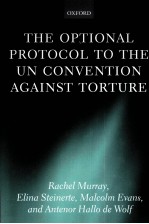
- 作 者:Rachel Murray ... et al.
- 出 版 社:Oxford University Press
- 出版年份:2011
- ISBN:0191729485
- 标注页数:241 页
- PDF页数:259 页
请阅读订购服务说明与试读!
订购服务说明
1、本站所有的书默认都是PDF格式,该格式图书只能阅读和打印,不能再次编辑。
2、除分上下册或者多册的情况下,一般PDF页数一定要大于标注页数才建议下单购买。【本资源259 ≥241页】
图书下载及付费说明
1、所有的电子图书为PDF格式,支持电脑、手机、平板等各类电子设备阅读;可以任意拷贝文件到不同的阅读设备里进行阅读。
2、电子图书在提交订单后一般半小时内处理完成,最晚48小时内处理完成。(非工作日购买会延迟)
3、所有的电子图书都是原书直接扫描方式制作而成。
1. The Origins and Background of OPCAT 1
A. Introduction 1
B. The Origins of the Optional Protocol 6
C. The European Convention for the Prevention of Torture 10
1. Drafting the ECPT 10
2. The work of the CPT and some implications for the drafting of OPCAT 18
2. Drafting OPCAT owards Deadlock: 1991-2000 22
A. The Return to the UN and its Consequences 22
B. The Principal Points of Agreement Prior to the 2001 Session and Their Place in the Final Text 27
C. The Principal Points in Dispute Prior to the 2001 Session 31
1. The visiting programme 32
2. Restrictions on access to persons in, or to places of, detention 35
3. The aftermath of a visit or mission 36
4. Reservations 37
D. An Assessment of the Overall Situation 38
3. The Text of OPCAT 39
A. The 2001 Session: New Ideas and New Controversies 40
1. The Mexican Draft 40
2. The EU proposals 43
B. The Chair's Compromise Text: The Optional Protocol and What It Requires of States 45
1. The Subcommittee and its visiting mandate 48
2. The National Preventive Mechanisms 53
3. Conclusion 57
C. The 'What' and the 'With What' Questions 57
1. The'Concept of prevention' 58
2. Standards 63
4. The Scope of OPCAT 68
A. 'Deprived of liberty' 69
B. Public and Private: '... either by virtue of an order given by a public authority or at its instigation or with its consent or acquiescence', Article 4(1) 70
C. '... are or may be deprived"/`installations and facilities' 73
D. 'any place/all places of detention' 73
1. Prisons, police, and pre-trial facilities 73
2. Refugee, asylum, and immigration centres 74
3. Military detention facilities 75
4. Mental health institutions 75
5. Care homes, foster homes, older persons, and other places 76
E. '... under its jurisdiction or control' 77
1. Nationally 78
2. Extra-territoriality 79
F. Article 14(2) Objection to a Visit by the SPT 81
G. Some Core Issues 82
1. Different approaches and requirements 82
2. Expertise 83
3. Coordination 85
4. Consistency in standards 87
H. Conclusion 89
5. The Role of the Subcommittee on Prevention of Torture (SPT) 90
A. The Membership of the SPT 92
B. The Interpretation of Its Own Mandate and Rules of Procedure 95
C. Pillar Ⅰ: Visits to States Parties 97
1. Selection of the countries: criteria, types of visits, and frequency 97
2. Content of the visit: choosing places of deprivation of liberty to be visited 102
3. Preventive approach and visits 103
4. Outcomes of a visit: the ongoing dialogue and follow-up 105
D. Pillar Ⅱ: work with the NPMs 108
1. SPT as adviser to the NPMs 111
E. Pillar Ⅲ: Cooperation with Other UN and International and Regional Bodies 112
F. Challenges Noted by the SPT 112
G. Conclusion 113
6. The Role of NPMs 115
A. Introduction 115
B. Visiting Powers and Mandate 117
C. Independence 119
1. Factors within the control of the State 120
2. Factors within the control of the NPM itself 124
D. Accountability and the Relationship with the SPT 128
E. NPMs Should Ensure States Comply with the UNCAT and Other Relevant Legal Standards 132
F. As a Forerunner to SPT Visits; Continuation of CPT Nationally; as a Small SPT on the Ground 133
G. Have Expertise 134
H. Large Expectations and Role Not Always Clear 136
I. Additional Factors for an Effective NPM 136
J. Conclusion 137
7. OPCAT within the Broader UN and Regional Systems 139
A. OPCAT and the Convention Against Torture 139
B. Engagement with Other UN Bodies 143
C. Engagement with Regional and Other Bodies 146
D. Some Common Issues 155
1. Confidentiality 155
2. Standards/norms 156
3. The need for consistency in engagement with NPMs 157
E. Conclusion: The Need for Systematic and Strategic Engagement 159
8. Regional Trends towards Ratification and Implementation of OPCAT 162
A. Reasons For and Against Ratification 162
B. The Added Value of Being Parties to OPCAT 168
C. Trends in the Choices for NPMs 170
D. Some Concluding Thoughts 172
9. Conclusion: Emerging Trends and the Future of OPCAT 174
A. Expansion of Membership of OPCAT 175
B. Expertise on OPCAT 176
C. A 'System' of Prevention Through Visits 177
D. Budget and Financial Resources 178
E. Standards and Accommodating Regional Differences 179
F. Influence and Lessons for Other Treaties 180
G. Conclusion 183
Appendices 184
Appendix Ⅰ: Optional Protocol to the Convention against Torture and Other Cruel, Inhuman or Degrading Treatment or Punishment 184
Appendix Ⅱ: Rules of Procedure of the Subcommittee on Prevention of Torture and Other Cruel, Inhuman or Degrading Treatment or Punishment 195
Appendix Ⅲ: Guidelines of the Subcommittee on Prevention of Torture and Other Cruel, Inhuman or Degrading Treatment or Punishment in relation to Visits to States Parties 205
Appendix Ⅳ: Preliminary Guidelines for the Ongoing Development of National Preventive Mechanisms 212
Appendix Ⅴ: Guidelines on National Preventive Mechanisms 214
Appendix Ⅵ: The approach of the Subcommittee on Prevention of Torture to the concept of prevention of torture and other cruel, inhuman or degrading treatment or punishment under the Optional Protocol to the Convention against Torture and Other Cruel, Inhuman or Degrading Treatment or Punishment 218
Appendix Ⅶ: Members of the Subcommittee on Prevention of Torture (SPT) as at January 2011 222
Appendix Ⅷ: Chronology of States Visited by the SPT 223
Bibliography 224
Index 237
